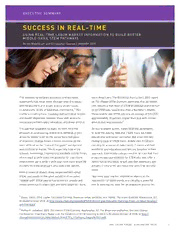Table Of ContentEXECUTIVE SUMMARY
SUCCESS IN REAL-TIME
USING REAL-TIME LABOR MARKET INFORMATION TO BUILD BETTER
MIDDLE-SKILL STEM PATHWAYS
By Ian Rosenblum and Christopher Spence | JANUARY 2015
The relationship between education and economic more Americans. The Brookings Institution’s 2013 report
opportunity has never been stronger than it is today— on The Hidden STEM Economy estimates that 26 million
with employment and wages directly proportional jobs require a high level of STEM knowledge and that half
to Americans’ levels of education and training.1 This of all STEM jobs require less than a Bachelor’s degree.
reality is creating deep, troubling and persistent income These middle-skill STEM jobs pay an average of $53,000,
and wealth disparities between those with access to approximately 10 percent higher than jobs with similar
successful postsecondary education, and those without. educational requirements.2
The gap that separates so many workers from the By taking urgent action, states have the opportunity
prospect of good-paying, stable jobs demands urgent to level the playing field and create more equitable
action by states—even as the unrelenting fast pace educational and career outcomes. But given the fast-
of economic change makes a sound response all the changing pace of STEM fields, middle-skill STEM jobs
more difficult as the “rules of the game” are dynamic can only be a source of opportunity if states and their
and continue to evolve. This is especially true in the workforce and education partners are targeted in their
Science, Technology, Engineering and Math (STEM) fields, approach. Community colleges need to be sure that their
where rapid growth holds the potential for significant programs educate students for STEM jobs that offer a
employment gains while a skills gap holds back would-be family-sustaining wage, target jobs that employers are
workers from the employers who seek their talents. actually trying to fill, and teach the skills that workers
need.
Recent research dispels many misperceptions about
STEM, and points to the great potential of so-called Real-time labor market information stands at the
“middle-skill” STEM jobs to fuel economic growth and intersection of these trends and can play a powerful
create pathways to stable jobs and solid wages for many role in meeting the need for an alignment process for
1
Baum, Sandy. 2014. Higher Education Earnings Premium: Value, Variation, and Trends. The Urban Institute. Washington, D.C.
Accessed October 2014, at http://www.urban.org/UploadedPDF/413033-Higher-Education-Earnings-Premium-Value-Variation-
and-Trends.pdf
2
Rothwell, Jonathan. 2013. The Hidden STEM Economy. Washington, DC: The Brookings Institution; See also Change
the Equation. Vital Signs: Reports on the Condition of STEM Learning in the U.S. Accessed October 4, 2014, at http://
changetheequation.org/sites/default/files/CTEq_VitalSigns_Supply%20(2).pdf.
JOBS FOR THE FUTURE | ACHIEVING THE DREAM 1
the modern economy—and especially for the middle- Recommendation 3: Strengthen state-level data systems
skill STEM careers that hold so much potential for the to support real-time LMI. States should create seamlessly
nation’s future. By providing a window into the dynamic linked data systems that follow students from pre-
needs of employers—the knowledge, skills, experience, kindergarten into the workforce, with particular emphasis
credentials and other assets they seek while hiring—real- on incorporating real-time labor market information
time labor market information (LMI) gives states and their and providing the kinds of data that will be most helpful
community colleges the ability to keep up with labor shifts for aligning education and training programs. Data that
and better prepare their citizenry for exciting career follows students from educational programs into the
opportunities and advancement. labor market is especially important for middle-skill
STEM fields, which are often marked by fast-changing
Drawing on best practices from states, college
technological advances and employer needs, and thus
systems and individuals institutions, the following
require a mechanism that ensures education programs
recommendations offer a framework for supporting
and their graduates are keeping pace.
the use of real-time LMI as community colleges build
pathways to completion in middle-skill STEM fields. Recommendation 4: Support institutions’ use of real-
time LMI through technical assistance and professional
Recommendation 1: Implement real-time LMI as a long-
development. To implement successful strategies that
term change management strategy—not a one-time tool.
develop and align middle-skill STEM pathways using
A state’s overall approach to labor market information
real-time labor market information, states must help
should position real-time LMI not as a tool for one-time
community colleges create capacity and knowledge
decision-making—which would be quickly outdated—but
among key stakeholders. States should complement an
rather as the bedrock of a long-term strategy for linking
overall vision that embraces and directs the use of real-
employers, community colleges, workforce systems,
time labor market information in education and training
economic development agencies and other stakeholders
systems with practical and comprehensive efforts to
to ensure the ongoing alignment of a state’s education
provide technical assistance, professional development
and training systems.
and other critical supports—including financial resources.
Recommendation 2: Make real-time LMI available and
Recommendation 5: Integrate real-time LMI into critical
usable by community colleges and other stakeholders.
ongoing decision-making. The first four recommendations
States should consider ways to serve as a coordinator,
address how states can establish the context and
convener and/or contractor on behalf of their community
conditions for successful use of real-time labor market
colleges to access third-party real-time LMI. State action
information; the final—and crucial—step is to ensure that
can include evaluating and sharing information on
LMI is integrated throughout key decision-making at
vendors, creating common standards of use, establishing
the state, system and institutional levels. States should
model Requests for Proposals and contracts, and/or
articulate clear expectations and develop policies and
setting up a single statewide contract with multiple end
incentives to ensure that real-time LMI is incorporated
users.
into program evaluation, curriculum evaluation, employer
engagement, institutional strategic planning, and student-
facing supports and services, including advising.
Full report available at: http://www.jff.org/publications/success-real-time-using-real-time-labor-market-information-build-
better-middle-skill
2 SUCCESS IN REAL-TIME | EXECUTIVE SUMMARY

